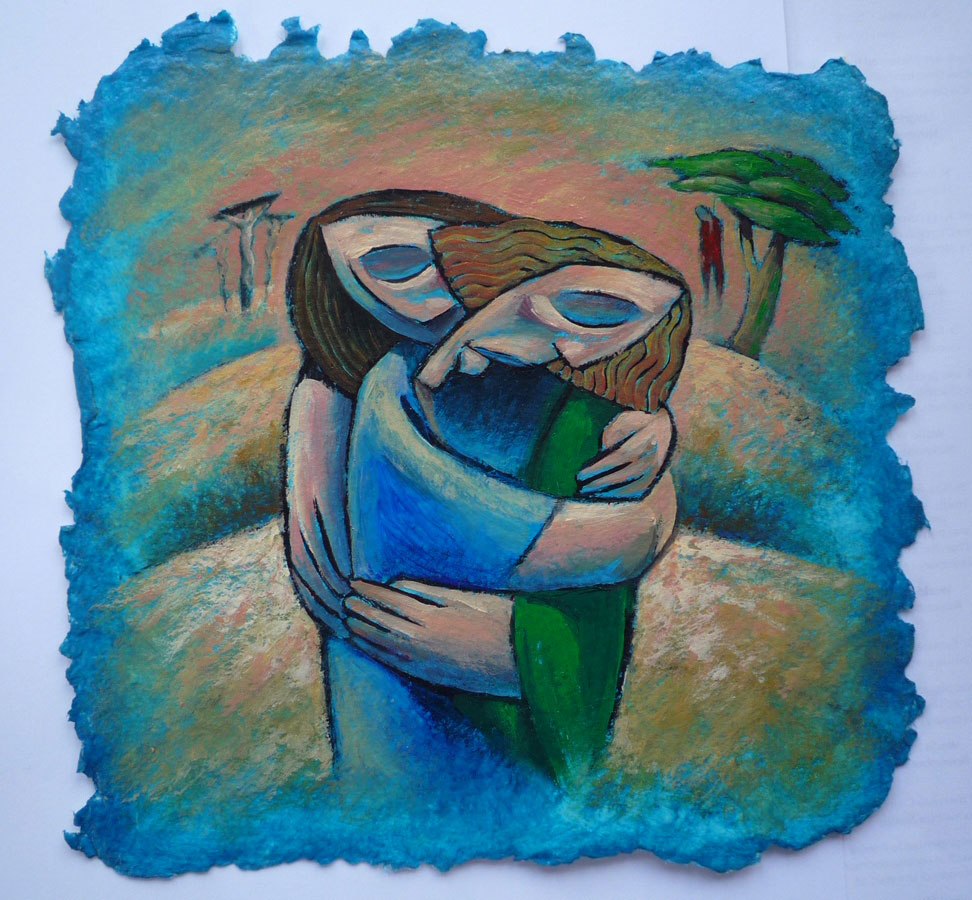
The Art of Hope through the Practice of Lament
New Testament scholar Christine Joynes explores how art can inspire, challenge and bring new meaning to lived reality
Since 2002 I have chaired a seminar exploring interpretations of the Bible in art, music and literature at the University of Oxford. Over these past two decades I have been repeatedly amazed at how art can bring sacred texts to life in new and helpful ways. This happens when we stop treating images simply as illustrations of sermon points (so often how art is used in churches). Rather we need to linger over the images and see artists as biblical interpreters, whose work can inspire and challenge us.
During the pandemic I have found much comfort in the biblical theme of lament as I have grappled with the devastation wrought by Covid-19. With Covid deaths now reported simply as numerical daily figures, swiftly passed over in the media, I suggest lament is a theme we should not leave behind so quickly as we contemplate how to define the future.

Lament is a theme I also discovered in a painting by Oxfordshire artist Nicholas Mynheer:
Mary embraces Judas’s mother (from his
Life of Mary series, 2014). The two mothers appear in the foreground, bound together by grief. The painting’s background reminds us why they are grieving – both have lost their sons, whose respective ends are depicted in the top left and top right corners of the image. Very different stories have brought them to the moment we see depicted (entirely imaginary of course), yet the artist calls upon his viewers to place themselves into their respective positions. By doing so, one engages with the biblical accounts of the passion in a very different way. Foregrounding the two women to me is also a significant sign of hope.The simplistic binary division between Jesus and Judas (as saviour and betrayer respectively) is overturned by the empathy the artist highlights between their mothers. To me this image speaks of forgiveness; of connectedness; of mission.
Mynheer expressly connects both lament and hope in his artwork on biblical themes during lockdown. For example, he writes in his blog (
www.mynheer-art.co.uk/blog.html) of the impact that the news of 13 year old Ismail Mohamed Abdulwahab’s death from Covid-19 had upon his sculpture of
Mary and the Christ Child (2021) for the Convent of St Mary, Wantage. He finds in his sculpture a source of hope as he discovers that the image of Mary as protective mother offers assurance that no child is alone and outside of God’s protective embrace. Here we find a two-way interaction between life and sacred story, as present experience impacts on the artist’s engagement with the Bible, and his meditation upon the Bible in turn brings new meaning to lived reality.
The two examples of Mynheer’s work I have highlighted above draw attention to the fact that biblical art does not aim simply to reproduce the content of our sacred narratives in pictorial form. Instead the artist engages with the Bible as a life-giving text which speaks to our present context. Both images prompt me to think about related gospel narratives from a different perspective – from the position of a parent who has lost a child; or through the lens of Mary’s parental responsibilities. This does not require me to be a parent; but it does require me to empathise and engage with positions other than my own. We are invited to stand in another person’s shoes and ask ourselves how the world might look from a different angle, de-centering ourselves.
My brief in writing this article was to discuss how, as we emerge from a global pandemic, art might offer hope, and I have chosen to interweave this theme with the importance of lament. During the pandemic another cause for lament came to the fore, namely the killing of George Floyd in May 2020. The details of this horrifying murder of a black man by a white police officer in Minneapolis quickly led to protest across the globe about police brutality towards black communities, with strong support expressed for the Black Lives Matter movement. As church communities considered how to respond, St Alban’s Cathedral took decisive action by using art. The cathedral chose to loan and put on display Lorna May Wadsworth’s
A Last Supper (2009), originally commissioned by St George’s Church, Nailsworth. The 12-foot-long oil on aluminium painting is a reworking of Leonardo da Vinci’s
Last Supper (1495-8), but instead depicts Jesus as a black Jamaican figure. The painting challenges traditional depictions of Jesus as a white, European man and thereby tackles the viewer’s assumptions and unconscious bias.

The artist clearly seeks to address the issue of the lack of inclusivity by the church and to challenge the dominance of paintings depicting a white Jesus (
www.lornamaywadsworth.com). In my view, art can highlight the issue of racial injustice much more directly than other media. (Names on undergraduate reading lists are far more obscure and can easily mask the absence of a diverse range of voices). Visual representation forces the artist to make clear choices which influence the viewer’s response. We should note at this point that Lorna May Wadsworth is a white, female portrait painter.
She has chosen to use her art to address the issue of racial injustice as an advocate, recognising that she cannot simply identify with the central character in her painting. This should caution us against assuming any straightforward equivalence between artist and subject. Whilst the artist’s agenda is self-evident in this particular example, we would do well to pause and acknowledge that we all bring our own assumptions and bias to the Bible, with or without the aid of art. The beauty of biblical art is that it forces us to directly confront those assumptions and examine them afresh.
The example of St Alban’s Cathedral has been followed more recently by Chester Cathedral, which also included Lorna May Wadsworth’s
A Last Supper in its exhibition,
Global Images of Christ (October 2021).
Thus whilst Wadsworth’s painting was not produced as a direct response to the murder of George Floyd, it has been used to good effect over the past eighteen months to speak to our current situation. This illustrates the power of art to be transformative: it can change our outlook and help us to see ourselves in new ways. Again we find a two-way conversation between lived reality and biblical text. My engagement with biblical art has alerted me to the way in which the Bible is a set of dynamic narratives, never finally understood, but constantly impacting on my experiences and revealing new insights about God and humanity. Through these examples of lament I have also discerned signs of hope.
Click here to
download a pdf version of this article
 Christine Joynes
Christine Joynes is a Regent’s Park College Tutorial Fellow in Theology and Director of the Centre for Baptist Studies. Her research interests lie in the interpretation of the New Testament, including in art, music and literature. She has been Departmental Lecturer in New Testament Studies at the Faculty of Theology and Religion at Oxford, as well as Director of the Centre for the Reception History of the Bible.
Images:
JESUS MAFA.
Jesus cures the man born blind, from Art in the Christian Tradition, a project of the Vanderbilt Divinity Library, Nashville, TN.
diglib.library.vanderbilt.edu/act-imagelink.pl?RC=48383
Mary Embraces Judas’ Mother, by Nicholas Mynheer
A Last Supper (2009) by Lorna May Wadsworth